Tianyu Yu
Process Reinforcement through Implicit Rewards
Feb 03, 2025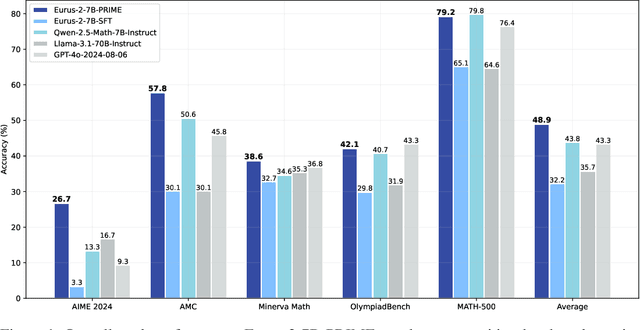

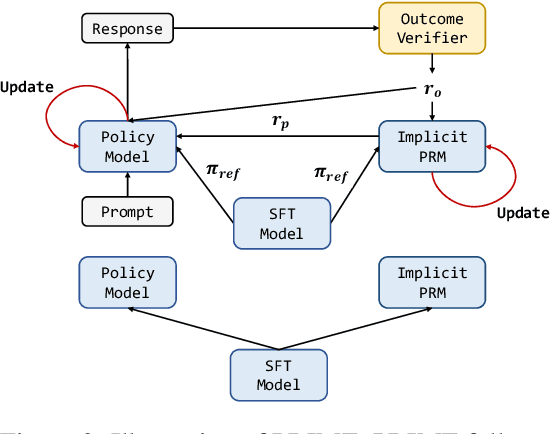
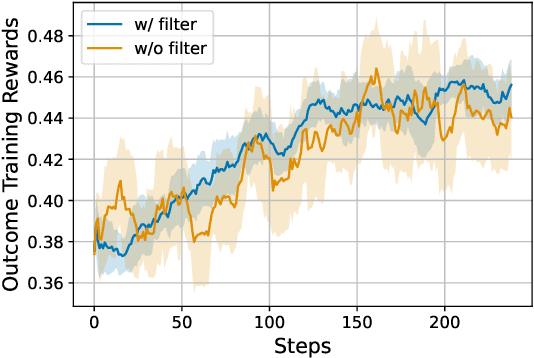
Abstract:Dense process rewards have proven a more effective alternative to the sparse outcome-level rewards in the inference-time scaling of large language models (LLMs), particularly in tasks requiring complex multi-step reasoning. While dense rewards also offer an appealing choice for the reinforcement learning (RL) of LLMs since their fine-grained rewards have the potential to address some inherent issues of outcome rewards, such as training efficiency and credit assignment, this potential remains largely unrealized. This can be primarily attributed to the challenges of training process reward models (PRMs) online, where collecting high-quality process labels is prohibitively expensive, making them particularly vulnerable to reward hacking. To address these challenges, we propose PRIME (Process Reinforcement through IMplicit rEwards), which enables online PRM updates using only policy rollouts and outcome labels through implict process rewards. PRIME combines well with various advantage functions and forgoes the dedicated reward model training phrase that existing approaches require, substantially reducing the development overhead. We demonstrate PRIME's effectiveness on competitional math and coding. Starting from Qwen2.5-Math-7B-Base, PRIME achieves a 15.1% average improvement across several key reasoning benchmarks over the SFT model. Notably, our resulting model, Eurus-2-7B-PRIME, surpasses Qwen2.5-Math-7B-Instruct on seven reasoning benchmarks with 10% of its training data.
EmbodiedEval: Evaluate Multimodal LLMs as Embodied Agents
Jan 21, 2025



Abstract:Multimodal Large Language Models (MLLMs) have shown significant advancements, providing a promising future for embodied agents. Existing benchmarks for evaluating MLLMs primarily utilize static images or videos, limiting assessments to non-interactive scenarios. Meanwhile, existing embodied AI benchmarks are task-specific and not diverse enough, which do not adequately evaluate the embodied capabilities of MLLMs. To address this, we propose EmbodiedEval, a comprehensive and interactive evaluation benchmark for MLLMs with embodied tasks. EmbodiedEval features 328 distinct tasks within 125 varied 3D scenes, each of which is rigorously selected and annotated. It covers a broad spectrum of existing embodied AI tasks with significantly enhanced diversity, all within a unified simulation and evaluation framework tailored for MLLMs. The tasks are organized into five categories: navigation, object interaction, social interaction, attribute question answering, and spatial question answering to assess different capabilities of the agents. We evaluated the state-of-the-art MLLMs on EmbodiedEval and found that they have a significant shortfall compared to human level on embodied tasks. Our analysis demonstrates the limitations of existing MLLMs in embodied capabilities, providing insights for their future development. We open-source all evaluation data and simulation framework at https://github.com/thunlp/EmbodiedEval.
Euclid: Supercharging Multimodal LLMs with Synthetic High-Fidelity Visual Descriptions
Dec 11, 2024Abstract:Multimodal large language models (MLLMs) have made rapid progress in recent years, yet continue to struggle with low-level visual perception (LLVP) -- particularly the ability to accurately describe the geometric details of an image. This capability is crucial for applications in areas such as robotics, medical image analysis, and manufacturing. In this paper, we first introduce Geoperception, a benchmark designed to evaluate an MLLM's ability to accurately transcribe 2D geometric information from an image. Using this benchmark, we demonstrate the limitations of leading MLLMs, and then conduct a comprehensive empirical study to explore strategies for improving their performance on geometric tasks. Our findings highlight the benefits of certain model architectures, training techniques, and data strategies, including the use of high-fidelity synthetic data and multi-stage training with a data curriculum. Notably, we find that a data curriculum enables models to learn challenging geometry understanding tasks which they fail to learn from scratch. Leveraging these insights, we develop Euclid, a family of models specifically optimized for strong low-level geometric perception. Although purely trained on synthetic multimodal data, Euclid shows strong generalization ability to novel geometry shapes. For instance, Euclid outperforms the best closed-source model, Gemini-1.5-Pro, by up to 58.56% on certain Geoperception benchmark tasks and 10.65% on average across all tasks.
A Topic-level Self-Correctional Approach to Mitigate Hallucinations in MLLMs
Nov 26, 2024



Abstract:Aligning the behaviors of Multimodal Large Language Models (MLLMs) with human preferences is crucial for developing robust and trustworthy AI systems. While recent attempts have employed human experts or powerful auxiliary AI systems to provide more accurate preference feedback, such as determining the preferable responses from MLLMs or directly rewriting hallucination-free responses, extensive resource overhead compromise the scalability of the feedback collection. In this work, we introduce Topic-level Preference Overwriting (TPO), a self-correctional approach that guide the model itself to mitigate its own hallucination at the topic level. Through a deconfounded strategy that replaces each topic within the response with the best or worst alternatives generated by the model itself, TPO creates more contrasting pairwise preference feedback, enhancing the feedback quality without human or proprietary model intervention. Notably, the experimental results demonstrate proposed TPO achieves state-of-the-art performance in trustworthiness, significantly reducing the object hallucinations by 92% and overall hallucinations by 38%. Code, model and data will be released.
MiniCPM-V: A GPT-4V Level MLLM on Your Phone
Aug 03, 2024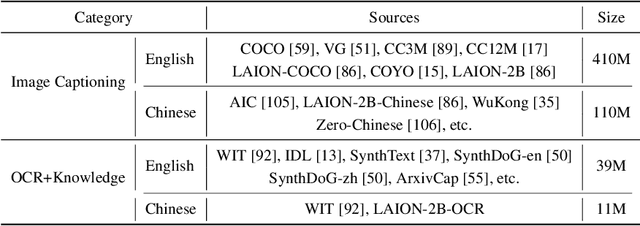
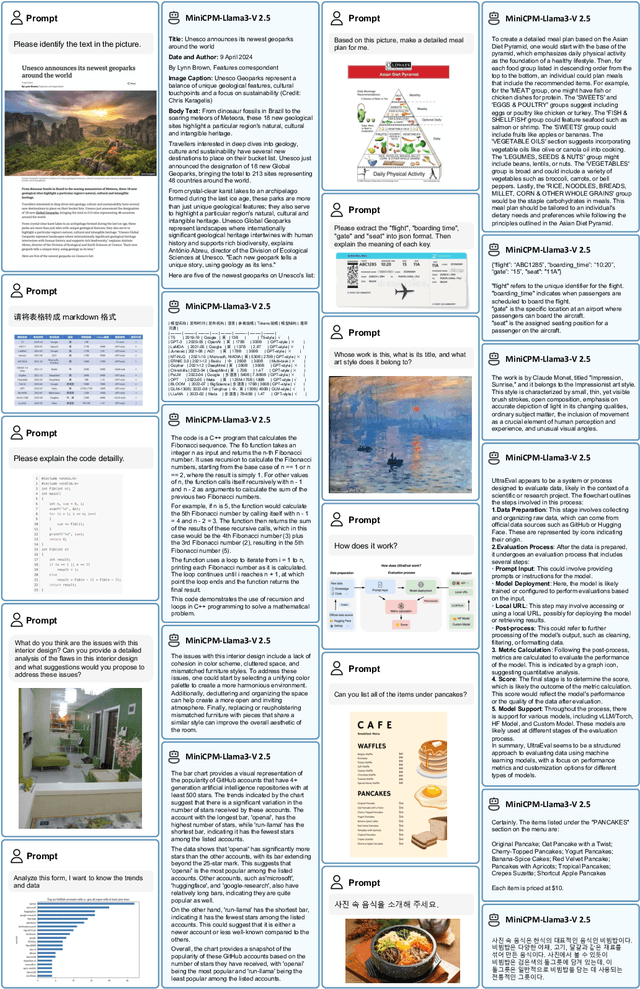
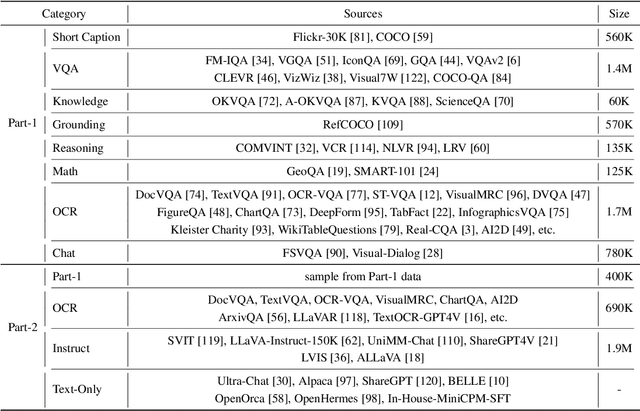
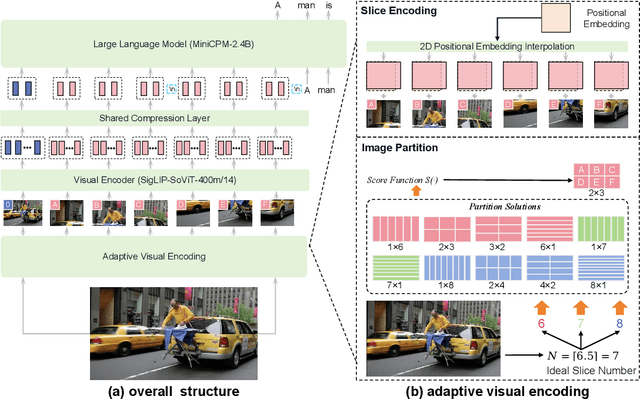
Abstract:The recent surge of Multimodal Large Language Models (MLLMs) has fundamentally reshaped the landscape of AI research and industry, shedding light on a promising path toward the next AI milestone. However, significant challenges remain preventing MLLMs from being practical in real-world applications. The most notable challenge comes from the huge cost of running an MLLM with a massive number of parameters and extensive computation. As a result, most MLLMs need to be deployed on high-performing cloud servers, which greatly limits their application scopes such as mobile, offline, energy-sensitive, and privacy-protective scenarios. In this work, we present MiniCPM-V, a series of efficient MLLMs deployable on end-side devices. By integrating the latest MLLM techniques in architecture, pretraining and alignment, the latest MiniCPM-Llama3-V 2.5 has several notable features: (1) Strong performance, outperforming GPT-4V-1106, Gemini Pro and Claude 3 on OpenCompass, a comprehensive evaluation over 11 popular benchmarks, (2) strong OCR capability and 1.8M pixel high-resolution image perception at any aspect ratio, (3) trustworthy behavior with low hallucination rates, (4) multilingual support for 30+ languages, and (5) efficient deployment on mobile phones. More importantly, MiniCPM-V can be viewed as a representative example of a promising trend: The model sizes for achieving usable (e.g., GPT-4V) level performance are rapidly decreasing, along with the fast growth of end-side computation capacity. This jointly shows that GPT-4V level MLLMs deployed on end devices are becoming increasingly possible, unlocking a wider spectrum of real-world AI applications in the near future.
RLAIF-V: Aligning MLLMs through Open-Source AI Feedback for Super GPT-4V Trustworthiness
May 27, 2024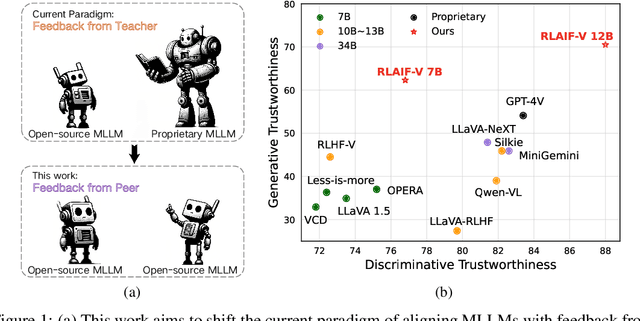
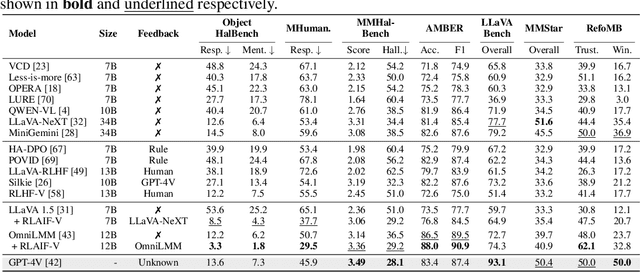
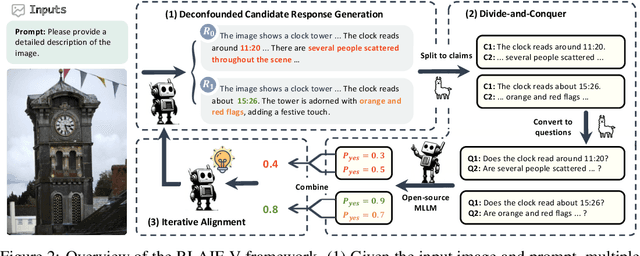
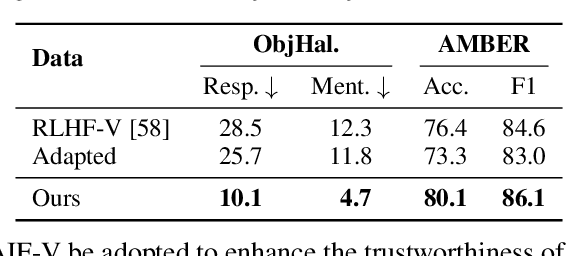
Abstract:Learning from feedback reduces the hallucination of multimodal large language models (MLLMs) by aligning them with human preferences. While traditional methods rely on labor-intensive and time-consuming manual labeling, recent approaches employing models as automatic labelers have shown promising results without human intervention. However, these methods heavily rely on costly proprietary models like GPT-4V, resulting in scalability issues. Moreover, this paradigm essentially distills the proprietary models to provide a temporary solution to quickly bridge the performance gap. As this gap continues to shrink, the community is soon facing the essential challenge of aligning MLLMs using labeler models of comparable capability. In this work, we introduce RLAIF-V, a novel framework that aligns MLLMs in a fully open-source paradigm for super GPT-4V trustworthiness. RLAIF-V maximally exploits the open-source feedback from two perspectives, including high-quality feedback data and online feedback learning algorithm. Extensive experiments on seven benchmarks in both automatic and human evaluation show that RLAIF-V substantially enhances the trustworthiness of models without sacrificing performance on other tasks. Using a 34B model as labeler, RLAIF-V 7B model reduces object hallucination by 82.9\% and overall hallucination by 42.1\%, outperforming the labeler model. Remarkably, RLAIF-V also reveals the self-alignment potential of open-source MLLMs, where a 12B model can learn from the feedback of itself to achieve less than 29.5\% overall hallucination rate, surpassing GPT-4V (45.9\%) by a large margin. The results shed light on a promising route to enhance the efficacy of leading-edge MLLMs.
UltraWiki: Ultra-fine-grained Entity Set Expansion with Negative Seed Entities
Mar 07, 2024



Abstract:Entity Set Expansion (ESE) aims to identify new entities belonging to the same semantic class as a given set of seed entities. Traditional methods primarily relied on positive seed entities to represent a target semantic class, which poses challenge for the representation of ultra-fine-grained semantic classes. Ultra-fine-grained semantic classes are defined based on fine-grained semantic classes with more specific attribute constraints. Describing it with positive seed entities alone cause two issues: (i) Ambiguity among ultra-fine-grained semantic classes. (ii) Inability to define "unwanted" semantic. Due to these inherent shortcomings, previous methods struggle to address the ultra-fine-grained ESE (Ultra-ESE). To solve this issue, we first introduce negative seed entities in the inputs, which belong to the same fine-grained semantic class as the positive seed entities but differ in certain attributes. Negative seed entities eliminate the semantic ambiguity by contrast between positive and negative attributes. Meanwhile, it provide a straightforward way to express "unwanted". To assess model performance in Ultra-ESE, we constructed UltraWiki, the first large-scale dataset tailored for Ultra-ESE. UltraWiki encompasses 236 ultra-fine-grained semantic classes, where each query of them is represented with 3-5 positive and negative seed entities. A retrieval-based framework RetExpan and a generation-based framework GenExpan are proposed to comprehensively assess the efficacy of large language models from two different paradigms in Ultra-ESE. Moreover, we devised three strategies to enhance models' comprehension of ultra-fine-grained entities semantics: contrastive learning, retrieval augmentation, and chain-of-thought reasoning. Extensive experiments confirm the effectiveness of our proposed strategies and also reveal that there remains a large space for improvement in Ultra-ESE.
RLHF-V: Towards Trustworthy MLLMs via Behavior Alignment from Fine-grained Correctional Human Feedback
Dec 01, 2023Abstract:Multimodal Large Language Models (MLLMs) have recently demonstrated impressive capabilities in multimodal understanding, reasoning, and interaction. However, existing MLLMs prevalently suffer from serious hallucination problems, generating text that is not factually grounded in associated images. The problem makes existing MLLMs untrustworthy and thus impractical in real-world (especially high-stakes) applications. To address the challenge, we present RLHF-V, which enhances MLLM trustworthiness via behavior alignment from fine-grained correctional human feedback. Specifically, RLHF-V collects human preference in the form of segment-level corrections on hallucinations, and performs dense direct preference optimization over the human feedback. Comprehensive experiments on five benchmarks in both automatic and human evaluation show that, RLHF-V can enable substantially more trustworthy MLLM behaviors with promising data and computation efficiency. Remarkably, using 1.4k annotated data samples, RLHF-V significantly reduces the hallucination rate of the base MLLM by 34.8%, outperforming the concurrent LLaVA-RLHF trained on 10k annotated data. The final model achieves state-of-the-art performance in trustworthiness among open-source MLLMs, and shows better robustness than GPT-4V in preventing hallucinations aroused from over-generalization. We open-source our code, model, and data at https://github.com/RLHF-V/RLHF-V.
Reformulating Vision-Language Foundation Models and Datasets Towards Universal Multimodal Assistants
Oct 01, 2023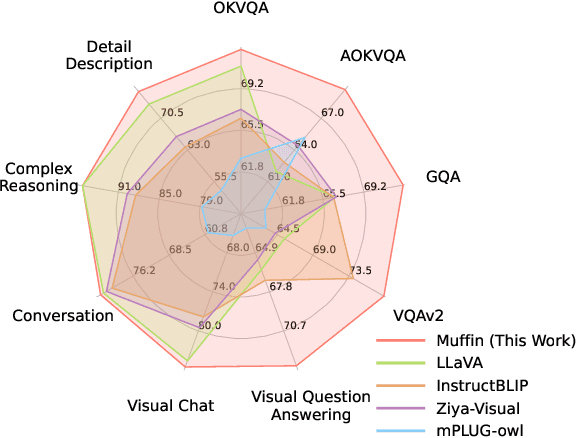
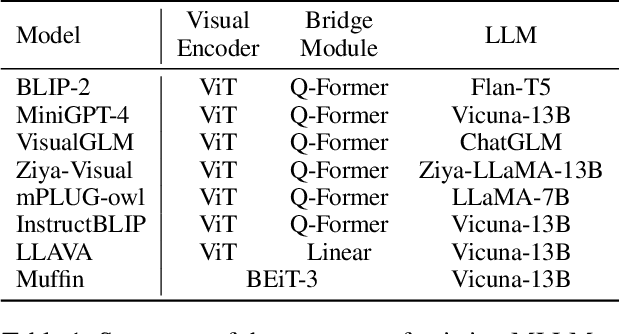
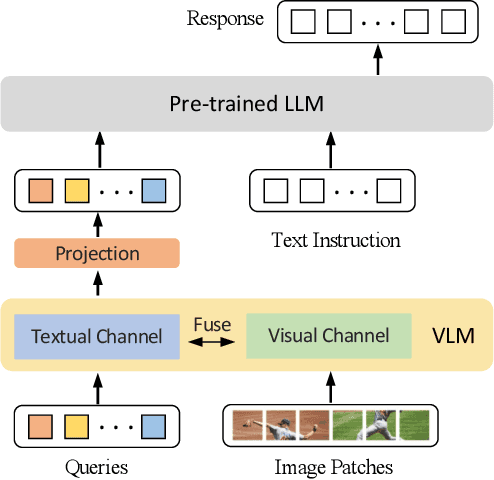

Abstract:Recent Multimodal Large Language Models (MLLMs) exhibit impressive abilities to perceive images and follow open-ended instructions. The capabilities of MLLMs depend on two crucial factors: the model architecture to facilitate the feature alignment of visual modules and large language models; the multimodal instruction tuning datasets for human instruction following. (i) For the model architecture, most existing models introduce an external bridge module to connect vision encoders with language models, which needs an additional feature-alignment pre-training. In this work, we discover that compact pre-trained vision language models can inherently serve as ``out-of-the-box'' bridges between vision and language. Based on this, we propose Muffin framework, which directly employs pre-trained vision-language models to act as providers of visual signals. (ii) For the multimodal instruction tuning datasets, existing methods omit the complementary relationship between different datasets and simply mix datasets from different tasks. Instead, we propose UniMM-Chat dataset which explores the complementarities of datasets to generate 1.1M high-quality and diverse multimodal instructions. We merge information describing the same image from diverse datasets and transforms it into more knowledge-intensive conversation data. Experimental results demonstrate the effectiveness of the Muffin framework and UniMM-Chat dataset. Muffin achieves state-of-the-art performance on a wide range of vision-language tasks, significantly surpassing state-of-the-art models like LLaVA and InstructBLIP. Our model and dataset are all accessible at https://github.com/thunlp/muffin.
Large Multilingual Models Pivot Zero-Shot Multimodal Learning across Languages
Aug 23, 2023



Abstract:Recently there has been a significant surge in multimodal learning in terms of both image-to-text and text-to-image generation. However, the success is typically limited to English, leaving other languages largely behind. Building a competitive counterpart in other languages is highly challenging due to the low-resource nature of non-English multimodal data (i.e., lack of large-scale, high-quality image-text data). In this work, we propose MPM, an effective training paradigm for training large multimodal models in low-resource languages. MPM demonstrates that Multilingual language models can Pivot zero-shot Multimodal learning across languages. Specifically, based on a strong multilingual large language model, multimodal models pretrained on English-only image-text data can well generalize to other languages in a zero-shot manner for both image-to-text and text-to-image generation, even surpassing models trained on image-text data in native languages. Taking Chinese as a practice of MPM, we build large multimodal models VisCPM in image-to-text and text-to-image generation, which achieve state-of-the-art (open-source) performance in Chinese. To facilitate future research, we open-source codes and model weights at https://github.com/OpenBMB/VisCPM.git.
 Add to Chrome
Add to Chrome Add to Firefox
Add to Firefox Add to Edge
Add to Edge